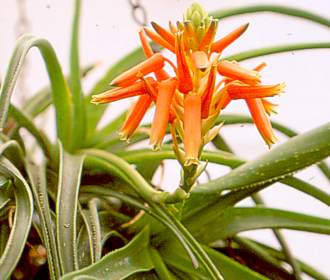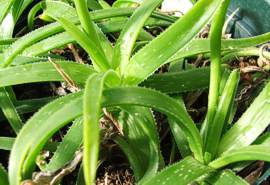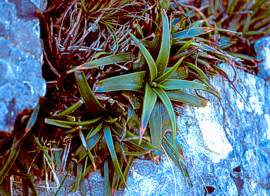Aloe thompsoniae
Aloe thompsoniae Groenew.
Family: Asphodelaceae
Common names: Wolkberg cliff aloe (Eng.), Wolkberg krans-aalwyn (Afr.).
Introduction
Aloe thompsoniae is an attractive dwarf aloe with dense rosettes of soft green leaves and orange-red flowers, which thrives in hanging baskets and containers.

Description
Description
Plants fast-growing, stemless, (or stems very short) with small dense rosettes, proliferating from the base from underground (subterranean) stolons to form small dense clusters up to 200 mm in diameter with soft recurved leaves. Stem ascending to horizontal, sometimes pendulous on shady cliff faces. The leaves are linear, softly succulent, channelled, green, and mottled towards the base, ascending and becoming recurved at the tip (apex), 50-200 mm long and 5-15 mm broad. The leaf margin is beset with very small teeth (denticulate).

The inflorescence is an ascending raceme 200-300 mm long bearing up to 5 pale pink sterile bracts clasping the stem. The 12-16 flowers are grouped together at the end in a head (capitate). They are drooping (sub-pendulous), orange-red and green-tipped, 27-30 mm long and 6-7 mm in diameter, on pedicels to 15-20 mm long.
Conservation Status
Status
Rare. Although Aloe thompsoniae has a limited distribution and is confined to the Wolkberg it is common in its habitat and not threatened. Plants often grow on inaccessible precipices and are thus well protected and out of reach.

Distribution and habitat
Distribution description
Aloe thompsoniae grows on mineral-poor quartzitic soil in sandstone rock crevices and is endemic to the Wolkberg near Polokwane (Limpopo Province). It is confined to the moist and well-watered sheer cliff faces and crevices in large boulders at an altitude of 1650-2100 m above sea level. Plants are often locally abundant. They grow mainly on shady, east- and south-facing aspects. Plants also grow on the summit and on boulders and are not restricted to cliffs. The temperature is moderate during summer, with frequent fog, and winters are dry and cool. The rainfall is about 1500-2000 mm per annum. Plants grow in Northern Escarpment Quartzite Sourveld of the Grassland Biome (Muchina et al. 2005). Associated plants in its habitat include Crassula pellucida subsp. alsinoides, C. setulosa, Bulbine natalensis, Aloe arborescens, Drimia robusta, Merwilla plumbea and Cyrtanthus junodii.
Derivation of name and historical aspects
History
Aloe thompsoniae is named in honour of Audrey Thompson the daughter of Sheila Thompson (fl. 1970), a grower of indigenous plants at Magoebaskloof who first collected the plant. It was named by Mr H.B. Groenewald in 1936 in the Afrikaans journal "Tydskrif vir Wetenskap en Kuns" (Vol. 14: 64).
Ecology
Ecology
Aloe thompsoniae flowers during summer (November-April) and sporadically at other times. It is pollinated mainly by sunbirds. The capsules ripen during autumn and the seeds are dispersed by the wind. It is related to A. nubigena, which can be distinguished at a glance by its leaves which are arranged in opposite rows (distichous) and have an entire margin.

Growing Aloe thompsoniae
Grow
Best grown in cool Afro-alpine or summer-rainfall grassland gardens in a slightly acid peat and sand mixture. Feed regularly during spring and summer. It is easily grown in a greenhouse in cool shady conditions. Keep moist and cool during the summer months.
Plants grow prolifically from the base and soon form clusters.They can be propagated by division or from offsets or seed. Sow during spring or summer. Germination is within 3 weeks and seedlings grow fast and plants should flower in the second or third year.
References
- Glen, H.F. & Hardy, D.S. 2000. Aloe thompsoniae Groenwald in Aloaceae (first part). Flora of Southern Africa. Volume 5, part 1. National Botanical Institute, Pretoria 2000.
- Mucina, L. & Rutherford, M. C. (Eds.) 2006. The vegetation of South Africa, Lesotho and Swaziland. Strelitzia 19. South African National Biodiversity Institute, Pretoria.
- Reynolds, G.W. 1974. The Aloes of South Africa. A.A. Balkema, Cape Town, Rotterdam.
- Van Wyk, B.E. & Smith, G.F. 1994. Guide to the Aloes of South Africa. Briza Publications, Pretoria.
Credits
Ernst van Jaarsveld
Kirstenbosch National Botanical Garden
May 2009
Plant Attributes:
Plant Type: Succulent
SA Distribution: Limpopo
Soil type: Sandy
Flowering season: Early Summer, Late Summer
PH: Acid, Neutral
Flower colour: Orange
Aspect: Full Sun, Morning Sun (Semi Shade), Afternoon Sun (Semi Shade)
Gardening skill: Easy
Special Features:
Horticultural zones







Rate this article
Article well written and informative
Rate this plant
Is this an interesting plant?
Login to add your Comment
Back to topNot registered yet? Click here to register.